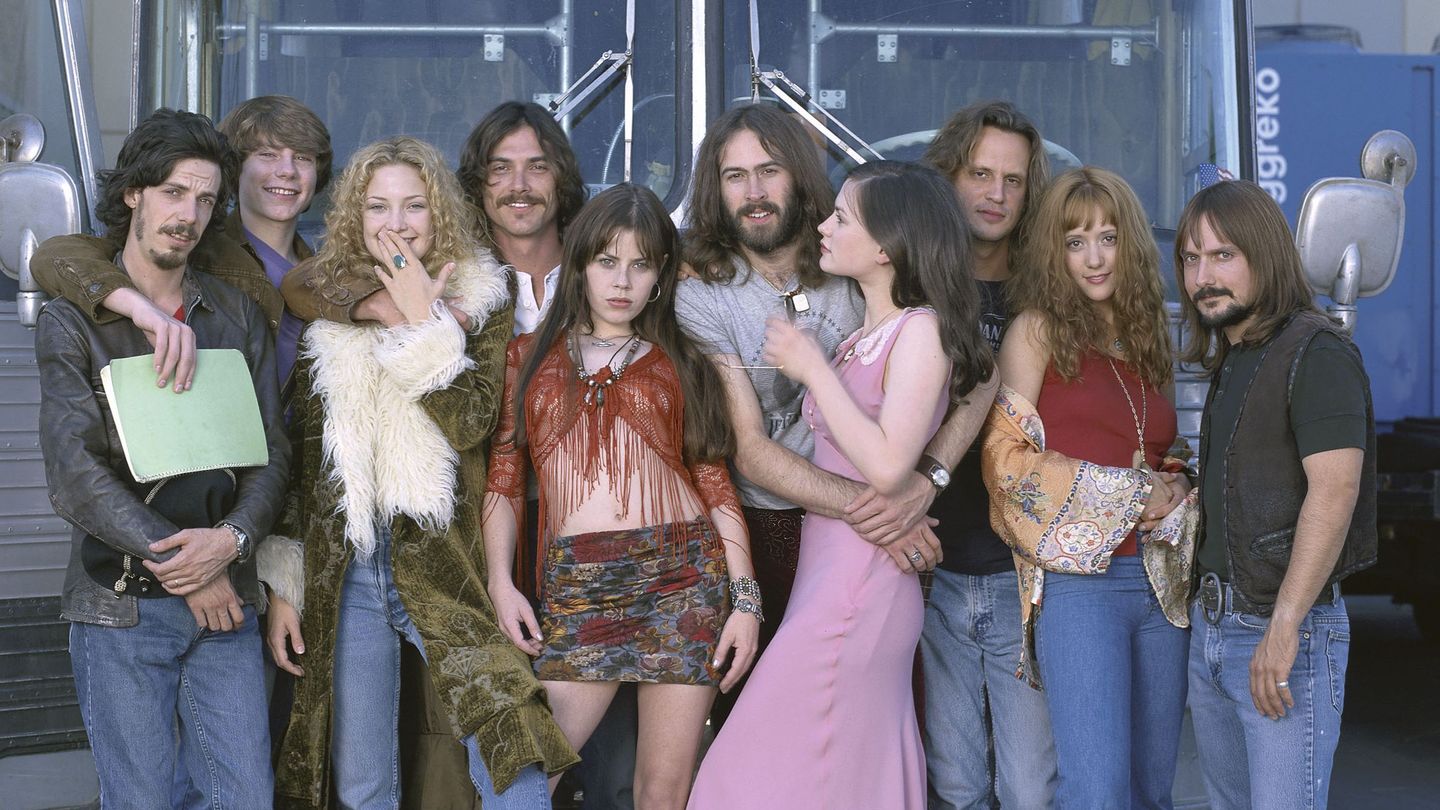
How Tiny Details Made Almost Famous’s Brand-New Outfits Look Old (And Iconic)
By Sara Radin
“Do you have to be depressed to write a sad song?†teenager William Miller, played by Patrick Fugit, asks rock star Russell Hammond, played by Billy Crudup, backstage. “Do you have to be in love to write a love song? Is a song better when it really happened to you?â€
The scene in writer-director Cameron Crowe’s 2000 semi-autobiographical film Almost Famous is one of many in which William’s maturity breaks through his youthful exterior and wardrobe (think white t-shirts and misfit jeans). It’s 1973, and William has been given the opportunity of a lifetime — to profile Hammond’s rising band Stillwater for the cover of Rolling Stone. It’s a gig any writer, let alone a 15-year-old, would dream of, and William’s ditched school, along with his overbearing mother, to make it happen. Crowe wrote his own real-life adolescence as a teen journalist for the magazine into the film, loading it with memorable quotes and humorous and emotional exchanges. The iconic outfits, though — like William’s brown suede jacket and Russell’s brown leather one — came courtesy of costume designer Betsy Heimann.
Heimann, who’s been bringing the stories of characters to life through clothes for more than three decades, has worked on some of the biggest movies of the past 30 years, including Jerry Maguire and Pulp Fiction. For Almost Famous, released on September 13, 2000 — 20 years ago — she worked closely with Crowe to translate his story authentically. Scouring fabric stores for scraps and looking at rock and roll tours from the time, Heimann helped piece together the narrative by employing her own interest in bringing out a character’s full range of emotions. From putting Penny Lane (Kate Hudson) in a translucent blouse to emphasize her vulnerability to creating the fur-lined coat of the century, Heimann played a huge role in making the film both period-appropriate and emotionally resonant.
MTV News sat down with Heimann to get more insight into the ways she illuminated the inner worlds of the characters via their dress.
MTV News: What drew you to the story? What was the process of translating the script like for you?
Betsy Heimann: When you read a script written by Cameron Crowe, it’s extremely inspirational. As a costume designer, you’re working to put the director’s vision together for people to see through clothes. It was a 1970s autobiographical film, and I had the greatest source of reference sitting right in front of me, Cameron. We looked at a lot of photographs of rock and roll tours from 1970 to 1973, some by friends of his, and that was our starting off point.
MTV News: Were there any specific musicians or tours you looked to?
Heimann: The photographs we looked at were from a Neil Young tour in 1973. Another one was the Allman Brothers and also The Eagles. It was not the birth of rock and roll by any means, but it was the end when people were there for the love of the music. Music wasn’t a big commercial entity at that time. The movie is an homage to that time.
When Jimmy Fallon’s character [a manager brought in by Stillwater’s label] enters the film, it’s the beginning of the end. But it wasn’t about how many t-shirts you could sell. It wasn’t about big tours with big money. Fallon brings that all to the party, and that’s a turning point in the film and was also a turning point in that kind of music.
MTV News: When it came to Patrick Fugit’s character, did you look at photos of Cameron Crowe, or what were your reference points for him?
Heimann: I was inspired by a photograph that was taken by Joel Bernstein of somebody that was on the tour with Neil Young in 1973. The photograph was of a man, but he was standing in a dressing room, just looking at the camera, and he looked very fish out of water. The picture was black and white. So I didn’t really have any sense of color, but it was just something in that moment that was captured with that person that inspired me for William. It didn’t really look at that many pictures of Cameron as a child, but his mother, absolutely. I looked at a lot of pictures of his mom cause you know, Frances McDormand is playing that part. Cameron’s mother was a wonderful woman and I had costumed her for Jerry Maguire.
 Courtesy of Paramount
Courtesy of ParamountMTV News: Let’s talk about Penny Lane and Kate Hudson. What were some of the references for that character? She had such iconic pieces.
Heimann: In terms of actual people, there was Pattie Boyd and Elaine Taylor. There was a picture of Pattie where she’s looking at herself in the mirror and she had a certain expression on her face and her hair was awesome. I just found that picture very inspirational. There were also some photographs by Baron Wolman, who was a photographer of the era.
But the biggest reference was the script. I mean, Penny Lane leapt off the page. She was a magical person. Cameron gave her a living, breathing heart and soul, so I just read the script and tried to notice any feelings I had about her. And then you combine that with Kate, who is just so joyous and beautiful and happy and vulnerable. You know, that’s how I work. I work from an emotional basis. Of course there’s always reference in every film I’ve ever done, but it comes from an emotional place of the character in the script. It’s mainly about the screenplay for me.
MTV News: Where did you source the clothing?
Heimann: I designed all of the clothes. They were all brand new, though some were made with vintage fabrics, and then we aged them down to look old. We sourced a lot of vintage clothing for the background people. Paramount Studios was closing down their costume department and they had a huge back room of fabrics that went all the way back in time to all the movies in the ‘30s and the ‘40s. And I found all kinds of things there. A lot of people think that all of the clothes came from thrift stores. I take that as a compliment because, you know, it has some authenticity to it. But in fact it was me with my little sketch pad. I tried to put myself in the period of Almost Famous and then make it my own.
MTV News: What’s the story behind Penny Lane’s coat?
Heimann: The coat was inspired by a drawing by Erté, who was an artist in the 1920s and ‘30s of an opera coat. That was my jumping-off point. The cream colored color really reflected the light of her face. And the coat itself was some drapery fabric. I wanted it to be like a cocoon for her because when she’d opened that coach, she was like a butterfly emerging from a cocoon. When she had that coat on, she was Penny Lane, and inside there was a very vulnerable girl. The coat itself was made out of some upholstery fabric I found in downtown L.A., and the collar was made out of a rug from Urban Outfitters. Oftentimes during a period film, you go back a little further in time. So some of what Penny was wearing had a lot of reference to the sixties.
 Courtesy of Paramount
Courtesy of ParamountMTV News: I love the little camisole she wears that’s like a crop top.
Heimann: Those were big in that period. I made her tops out of little vintage pieces of fabric and lace. I would find remnants of things that I like. That’s kind of what I do. I’ll take something old and turn it into something new.
MTV News: What about at the end? She goes to the airport and she’s wearing an elegant black outfit.
Heimann: That was a very Audrey Hepburn moment. Now she’s going to play the part of this mysterious movie star with the sunglasses and the black hat and the black dress. She’s going off to Morocco to play a different character and be somebody else. She’s like, “I’m going to leave this fantasy behind and go into the real world. But here I am starting it with a new fantasy.â€
MTV News: Let’s talk about Zooey Deschanel. I loved her in this movie and the way she kind of goes from being this teenager with her hair up in rollers to being a hip flight attendant.
Heimann: If my memory serves me well, Cameron’s sister actually had her hair in the rollers, and that was very important as was the curly hair for Penny Lane. There was an airline called PSA, Pacific Southwest Airlines, and that was their uniform. We had to make it because that airline had gone out of business but that was all referenced in research and we actually found a stewardess who lived in San Diego and we drove down there. We used her photographs and uniform to make Zooey’s, so it was an authentic reproduction.
I used a very restricted palette for the film. Brown, navy, brick, and avocado were my four main colors. And then there were the dusty roses and the dusty purple, but the Miller family wore a lot of red, which was really the only time you saw that color in the film.
 Courtesy of Paramount
Courtesy of ParamountMTV News: What was the meaning behind that choice?
Heimann: I think it was to say that they were in their own world. They just traveled to the beat of their own drum, the daughter, the mother, and the son were all uniquely different from each other, but in their own world. They did things the way they did them. It didn’t really matter what the rest of the world was doing.
MTV News: How does it feel to see so many people dressed up as Penny Lane for Halloween, and have such a cult following around the film?
Heimann: I think it’s fantastic, just a real tribute to the film and to the mood that we created, that we’ve created something lasting and that feels good. I’m just so flattered that here you are calling me and talking to me, it’s a wonderful thing. It’s great to still be in the consciousness of people. The film itself was a joyous experience for me, it’s very close to my heart and it’s really exciting that other people feel the same way.
Almost Famous is available for streaming on Apple TV.Â



